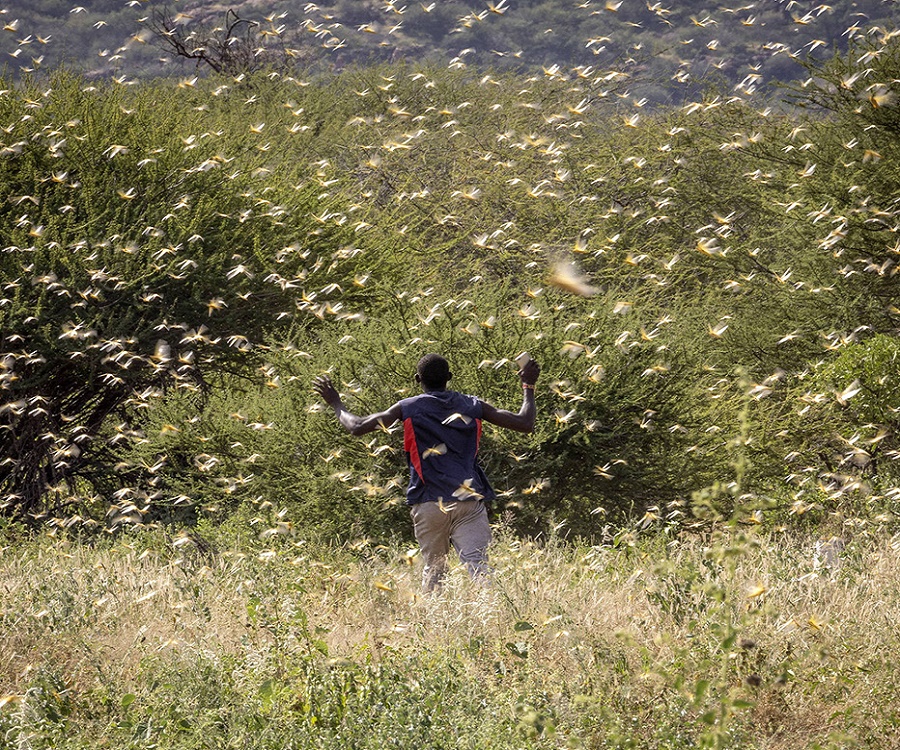Locusts: An unprecedented threat to food security & livelihood in Africa
The situation remains alarming in four countries of Eastern Africa - Djibouti, Eritrea, Ethiopia and Somalia - popularly known as the Horn of Africa. According to reports of Food and Agricultural Organization (FAO), locusts are populating in Somalia while mature locust swarms are arising from Kenya and infesting other countries.

- Country:
- Ethiopia
Locusts are causing unprecedented threat to food security and livelihoods at the beginning of the upcoming crop season. The reports also suggest that the situation is alarming in the horn of Africa and adjacent countries where breeding of locusts is in progress on a large scale.
“Fighting the locusts is half the battle. The other half is helping the people affected,” said Q U Dongyu, Director-General, FAO. This statement highlights the plight of farmers and farm labourers. Besides, the cascading effect of the crop destruction on food security is threatening the entire population of these countries, particularly the poor people. For instance, Kenya is now facing the mature stage of locusts from where new locust swarms are flying to infest other areas and also neighboring countries.
Horn of Africa infested with locusts
According to the latest forecast released by Locust Watch, a 24x7 monitoring platform of Food and Agriculture Organization ( FAO), the new locust swarms are in a breeding stage in Somalia but it will soon start producing mature locust swarms. However, aerial and ground control operations continue in Kenya but further concentration is expected in Marsabit and Turkana.
Besides, the locust swarms in Ethiopia continue to mature and breed over a widespread area of Oromiya and SNNPR regions, including the Rift Valley. Cross-border movements continued to be reported from adjacent areas of Somalia and Kenya.
Inside Spreading of Locusts
The locust swarms are now spreading inwards from the horns of Africa. According to agriculture observers, the locust swarms were also seen in Laboni area of South Sudan, which shares borders with Ethiopia and Eritrea. Scattered adults were also seen maturing on the central coast of the Red Sea. In the latest reports, Eritrea reported locust breeding.
Locusts swarms were also seen breeding on central and northern areas of the Red Sea coast. Besides, a mature swarm appeared on the coast near Massawa and laid eggs. However, this swarm was treated by ground control operations from 2172 ha of land on 24-26 February. Locust infestations have also been reported from South Sudan, Uganda, the United Republic of Tanzania.
Across the Red Sea
The locust swarms are reported in Yemen. According to reports, locust swarms were breeding and populating on the Red Sea coast. An immature swarm was seen in Sana'a on 29 February. New breeding was seen on the southern coast near Aden, where early and late instar hopper bands were present, the latter forming immature adult groups.
“If we overlooked Yemen it will give an open gate to locusts in Eretria and Djibouti. Same we can say for Saudi Arabia, Iran, Iraq, Afghanistan and Pakistan as locusts' mature and immature swarms were seen there,” said FAO's Desert Locust Information Service. It further added, “It is the worst outbreak to strike Ethiopia and Somalia for 25 years and the worst infestation that Kenya has experienced in 70 years,”. Last week, the new swarms appeared in Bahrain, Kuwait, Saudi Arabia, Qatar and reached the Islamic Republic of Iran.
The Way Ahead
FOA has appealed for 138 million donations from the global community. So far, FAO has received about 17 million Euros which is not enough. The Desert Locust is considered the most destructive migratory pest in the world. A swarm covering one square kilometre constitutes about 40 million locusts that can eat agriculture crops equivalent to one-day food of about 35,000 people. After destroying pastures and croplands, agriculture has come under direct attack. Therefore, in addition to killing the grasshoppers, the FAO has also recommended to clean the eggs by spraying insecticides in all the infested areas in Africa, Arabian Peninsula and South Asia.
Therefore, collective and integrated efforts are required for cleaning and killing of Locusts. It requires billions of dollars and close cooperation between the countries. The fight against locusts is like a war. Locusts are able to live on 52 types of plants including crops, beans, grass, trees, grasslands and forests. There must a robust and vibrant global plan to minimize the loss of crops. Besides, the organizations working for food security and health should also take cognizance of the problem and start preparation to deal with the imminent crisis of food security and related issues in Eastern Africa.
(Disclaimer: The opinions expressed are the personal views of the author. The facts and opinions appearing in the article do not reflect the views of Devdiscourse and Devdiscourse does not claim any responsibility for the same.)
- FIRST PUBLISHED IN:
- Devdiscourse
ALSO READ
Ghana's Tournament Streak in Jeopardy: A Battle for Africa Cup Qualification
JM Scindia Inaugurates SATRC-25, Highlights India’s Role in Digital Transformation and Connectivity in South Asia
HKMA and Global Finance Leaders Form Strategic Alliance to Drive Sustainable Investment in Asia
Yoon's Diplomatic Tour: Bridging Asia and the Americas
COP29 Opens in Baku: African Nations and AfDB Push for 'Green Wealth' Valuation and Climate Finance Boost










